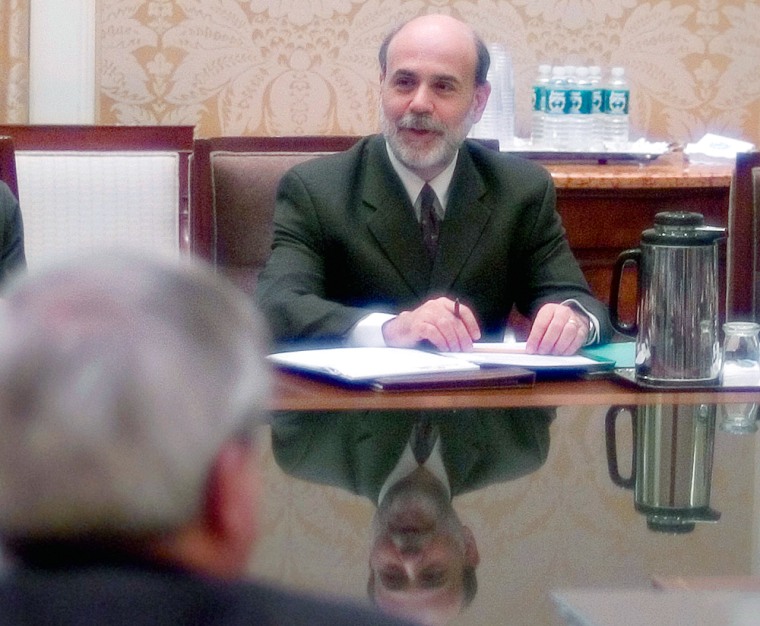Ben Bernanke unleashed his inner tough guy this week, raising interest rates and strongly hinting of more to come, but he did not make a believer out of everyone.
Before he took over as chairman of the Federal Reserve Feb. 1, Bernanke was best known for his concerns about the potential for deflation in 2002 and 2003. That gave him a reputation as being perhaps a bit soft on inflation, although by the time his first policy-making meeting rolled around this week, it was clear he would continue the policy of his predecessor Alan Greenspan and raise interest rates another quarter-percentage point, which he did Tuesday.
In transitioning to the Bernanke era, the Fed left part of its policy statement unchanged from Greenspan's final meeting Jan. 31, reiterating that "some further policy firming may be needed" to reach the Fed's goal. But the Bernanke-led committee also unveiled a slightly different approach in its assessment of economic conditions, offering a bit more of a forward-looking view and outlining some of the Fed's main concerns over the next several months.
Still, it was the "further policy firming" that jolted investors who had been hoping for more of a hint that the central bank is almost done with its 20-month rate hike campaign. The Dow Jones industrial average dropped sharply after the announcement and ended the week with a loss of about 1 percent, although the benchmark index still closed out the first quarter with a gain of 4 percent.
While most forecasters and market indicators reflect an assumption that the Fed will raise rates again at its next meeting of policy-makers May 10, some experts caution that the next move is not a given and will depend heavily on the data to be released over the next six weeks, including next Friday's employment report for March.
"I wouldn't go quite so far" as to say the next rate hike is already a sure thing, said Jan Hatzius, chief U.S. economist at Goldman Sachs. If the next two payroll reports are weak, "it's possible they skip. Certainly stranger things have happened." The Fed's statement about possible firming "was never intended to be a guarantee," he said.
For the record, Hatzius expects the Labor Department to report that employers added 175,000 jobs in March, in line with the average of the past several months. He predicts the Fed will raise the overnight federal funds rate rates another quarter-point to 5 percent May 10 and then hold it there as employment growth weakens through the spring and the economy slows from the above-average pace of the first quarter.
David Rosenberg, chief North American economist for Merrill Lynch, also is clinging to the idea that the Fed might leave rates unchanged May 10, although he acknowledges that another quarter-point increase is now the likeliest outcome. Prior to this week's meeting he had thought the Fed might raise rates to the current 4.75 percent rate and then pause.
Rosenberg, seeking support in the historical record, points out that after a meeting of policy-makers in May 2000, when the central bank aggressively raised rates a half-percentage point, policy-makers issued a statement the warned of "heightened inflation pressures" and was widely interpreted as signaling more increases to come.
Instead the Fed moved to the sidelines and then in 2001 began cutting rates aggressively as the economy slowed and eventually slipped into recession. He notes that the Fed moved to the sidelines that summer even though the latest employment report had shown an increase of more than 200,000 jobs. The jobless rate was edging up at the time but still a relatively low 4.1 percent, compared with 4.8 percent currently.
"In other words, it may take less for the Fed to go on hold than is generally appreciated," he said.
But Rosenberg's view seems to be in the minority, as more forecasters come around to the view that the Fed might boost rates three more times this year, bringing the overnight federal funds rate to 5.5 percent.
Rich Yamarone, director for economic research at Argus Research, has been predicting a 5.5 percent fed funds rate since August, so forgive him for gloating a bit as some of the more influential Wall Street forecasters come around to his point of view.
"Central bankers like to know the cork is firmly implanted in the bottle so that the inflation genie doesn’t sneak out," Yamarone said in a research note. "The worst thing a central bank can do when fighting inflation is fall behind the curve. Therefore, we are fairly comfortable with our Street-high estimate, and welcome those newcoming bulge-bracket firms aboard our bandwagon."
To Yamarone, the key factors are the surprisingly strong growth of the first quarter and rising energy prices that are threatening to spill over into more widespread inflation. The business press, he complains, focuses far too much on the "core" rate of inflation, which excludes food and energy prices.
But the Fed's statement Tuesday made clear that central bankers are watching energy prices carefully, saying "…the elevated prices of energy and other commodities have the potential to add to inflation pressures."
Yamarone said another misconception is that the Fed has been trying to cool the economy. In fact, he said the central bank has only moved interest rates from "overly accommodative" to the "neutral zone," where rates neither stimulate growth nor slow the economy.
"I think we still have a hike or two to get to then end of neutrality and one final one after that, which would be a little restrictive," he said. "And the Fed can afford to do that."
